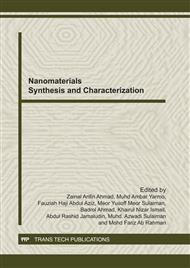p.12
p.16
p.20
p.25
p.30
p.35
p.40
p.45
p.50
Iron Oxide Nanoparticles Conjugated Monoclonal Antibody for Immunochromatographic Strip Test
Abstract:
In this study, the synthesis of iron oxide nanoparticles (IONPs) and immunochromatographic (ICG) strip test of iron oxide conjugated with monoclonal antibody (IONPs-Ab) have been developed. The IONPs were synthesised using precipitation method and dispersed in water by applying polyethylene glycol coating. Several parameters that affected conjugations of the IONPs-Ab were studied namely iron oxide concentration, antibody volume, stabilizer concentration and the amount of SiPEG coating. From the transmission electron microscopy (TEM) image, the size of IONPs obtained was ~14 nm. Conjugate was tested with the ICG strip test lined with the antigen. The results showed 1.0μl SiPEG coating, 1 M IONPs concentration, 20μl of 1mg/ml antibody volume and 1% bovine serum albumin (BSA) were the optimum. Moreover, the IONPs-Ab was also tested with the Brugian filariasis positive and negative serum samples. The results showed positive result for the patient serum and negative result for the non-patient serum in just 15 minutes.
Info:
Periodical:
Pages:
30-34
Citation:
Online since:
October 2011
Price:
Сopyright:
© 2012 Trans Tech Publications Ltd. All Rights Reserved
Share:
Citation:


